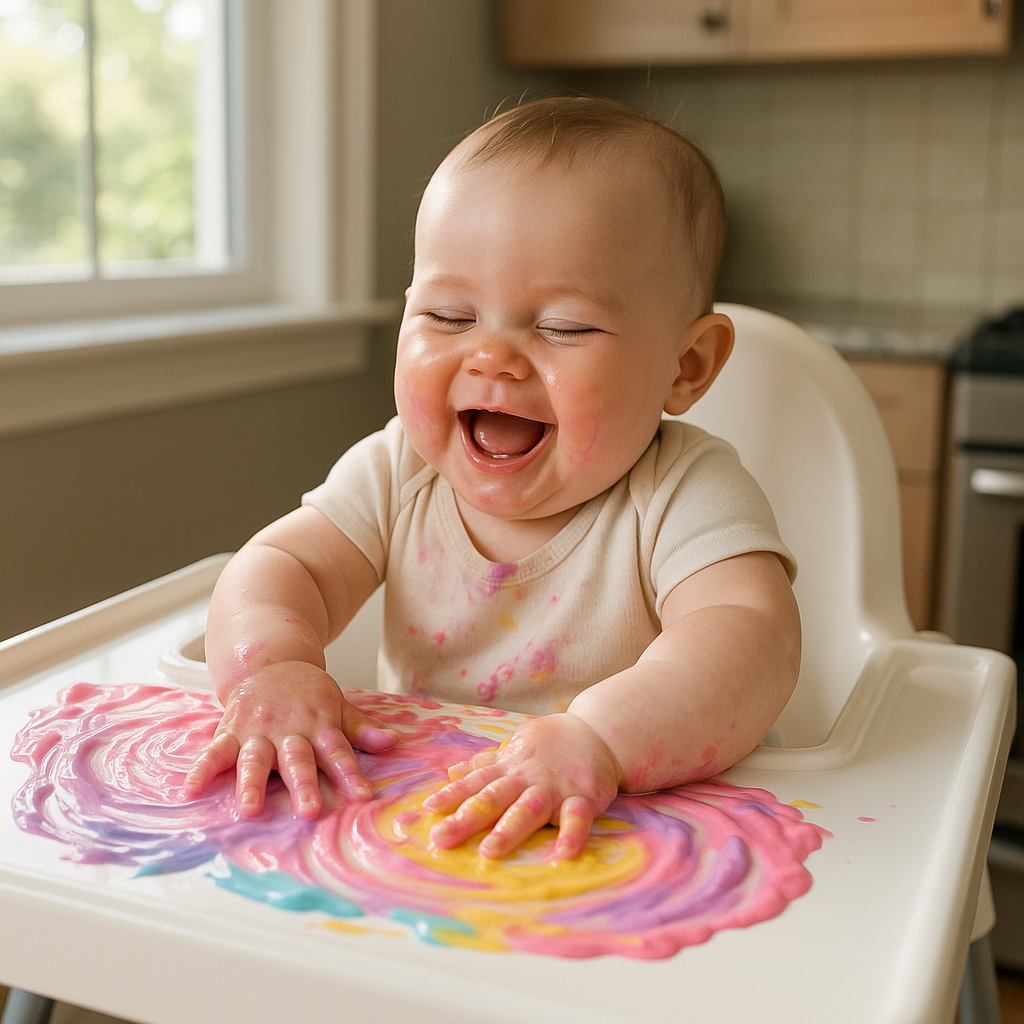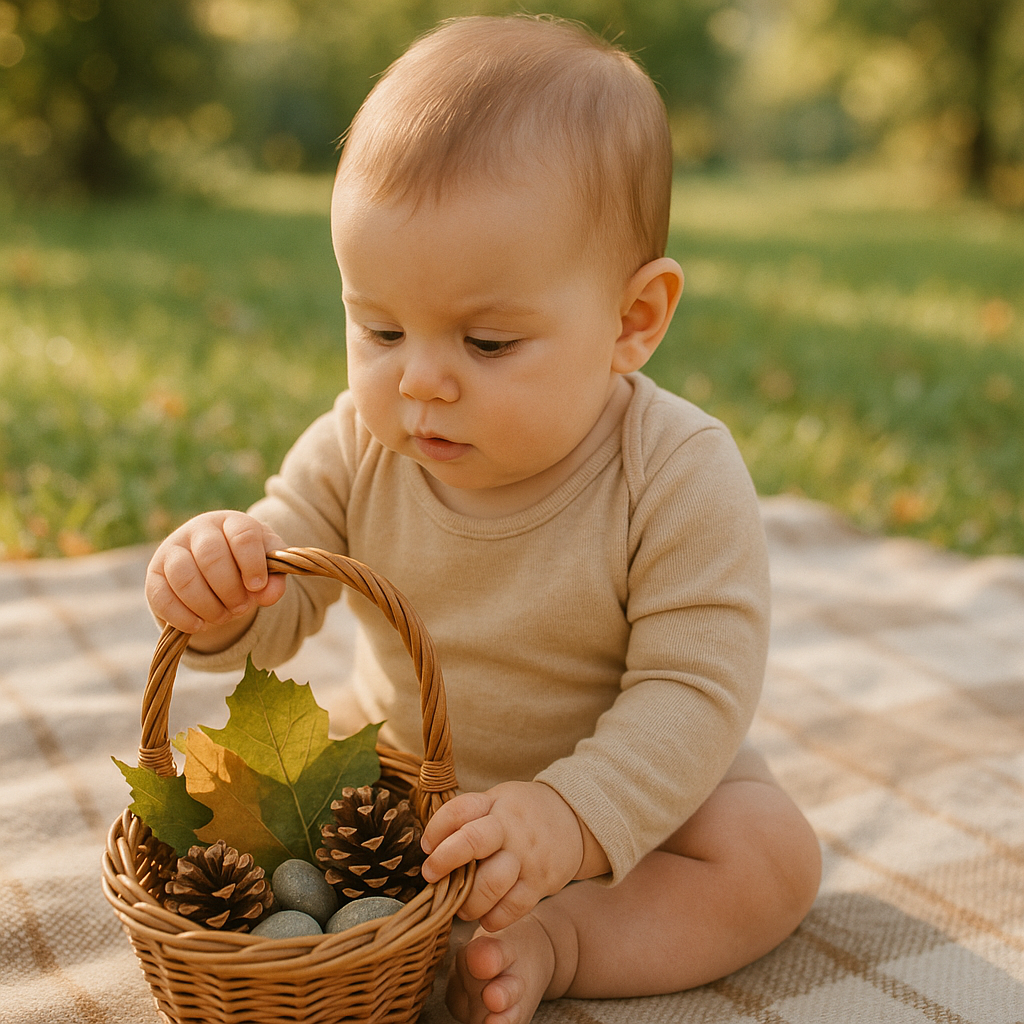Your baby’s brain forms up to 1 million neural connections every second, a process that shapes their learning and growth. Messy play—think squishing oatmeal or smearing yogurt—may seem chaotic, but its sensory richness fuels this rapid development. Unlike screen time, which can limit sensory input, messy play engages multiple senses, offering a richer learning experience. Learn more in The Messy Truth About Kids’ Screen Time.
- What exactly is messy play, and why does it matter before age 1?
- How does messy play build new neural pathways in your baby’s brain?
- Which cognitive skills get a boost from messy play?
- How does messy play strengthen fine and gross motor development?
- What language and social-emotional gains come from getting messy?
- How can you start messy play safely with a 0–12-month-old?
- How do you adapt messy play for sensory-sensitive or neuro-divergent babies?
- What mess-containment hacks keep parents sane?
- Which easy, research-backed activities should you try this week?
- Quick-fire answers to parents’ top messy-play questions
- Final Thoughts
What exactly is messy play, and why does it matter before age 1?
Messy play is open-ended sensory exploration led by babies. It involves activities like squishing finger paint, splashing water, or crunching leaves, where babies engage with textures, colors, and sounds. Before age 1, it matters because neuroplasticity—the brain’s ability to form and strengthen neural connections—peaks during the first two years. Sensory-rich experiences from messy play flood the brain with input, tightening synaptic networks more effectively than structured activities like flash cards. Research shows early visual and motor skills developed through such play can predict later math and language abilities. Discover more at Visual Spatial Processing Research.
Unlike passive screen time, messy play offers active engagement, supporting cognitive and motor growth, as noted in The Messy Truth About Kids’ Screen Time. For related activities, see Play vs. TV.

How does messy play build new neural pathways in your baby’s brain?
Messy play builds neural pathways by engaging the somatosensory cortex through sensory input. Each new texture, like gooey yogurt or crunchy leaves, activates the roughly 3,000 touch receptors per cm² in a baby’s fingertips, sending rapid signals that connect multiple brain regions. This multisensory stimulation strengthens neural wiring, supporting cognitive growth, as shown in Multisensory Integration and Child Neurodevelopment.
For example, handling warm and cool oatmeal engages temperature receptors, promoting myelination for faster, more reliable neural signals. Pairing messy play with activities like High-Contrast Books enhances visual-tactile connections, further boosting brain development.
Which cognitive skills get a boost from messy play?
Messy play boosts early executive functions like problem-solving, working memory, and cognitive flexibility. When a baby drops a spoon to watch it splash, they learn cause and effect. Mixing paint colors reveals new hues, fostering experimentation. Self-directed messy play encourages curiosity, with children asking more questions than in adult-led tasks, supporting cognitive development. These activities lay the foundation for skills like planning and adaptability. To further nurture curiosity, try ideas from Cause-and-Effect Play.
How does messy play strengthen fine and gross motor development?
Messy play strengthens fine and gross motor development through hands-on sensory activities. Small movements, like pinching gooey dough or scooping rice, refine the pincer grip and wrist rotation, essential for self-feeding and writing later. Larger actions, such as crawling over bubble wrap or reaching for paint, build core strength and engage the vestibular and proprioceptive systems, enhancing balance and body awareness. These activities support motor skill development. Combine messy play with Tummy Time Benefits to further boost motor growth.
What language and social-emotional gains come from getting messy?
Messy play boosts language and social-emotional development through interactive sensory experiences. Narrating actions, like describing “squishy” dough or “gritty” sand, enhances a baby’s receptive vocabulary for texture words, supporting communication skills, as noted in The Benefits of Messy Play for Toddlers. When parents model delight during play, mirror neurons activate, strengthening emotional bonds. Squeezing dough rhythmically can reduce stress, promoting calm and resilience. These interactions foster emotional regulation and social connection. Learn more in Nursery Rhymes to combine tactile and auditory learning for added language benefits.
How can you start messy play safely with a 0–12-month-old?
Start messy play safely with a 0–12-month-old by using taste-safe materials, ensuring constant supervision, and matching textures to age. Sensory activities stimulate brain development, but safety is key. Below is a guide for age-appropriate activities:
| Age | Activity | Goal |
|---|---|---|
| 3–6 m | Sealed water bag with glitter | Visual tracking, tummy time |
| 7–9 m | Edible finger paint (yogurt-based) | Hand-to-mouth exploration |
| 10–12 m | Sensory bin (cooked pasta, spoons) | Scooping, cause-and-effect |
Follow these tips:
- Use safe materials: Ensure items like yogurt or cooked pasta are taste-safe, as babies explore with their mouths.
- Check sizes: Parts should be larger than 4 cm to prevent choking, per safety guidelines.
- Patch-test allergens: Test new foods (e.g., yogurt) on skin 24 hours prior to avoid reactions.
- Supervise closely: Stay within arm’s reach to manage risks, as supported by Procare Software: Sensory Activities for Babies.
For more low-cost ideas, see DIY Baby Toys. These steps ensure messy play is both fun and safe, fostering neural growth without hazards.
How do you adapt messy play for sensory-sensitive or neuro-divergent babies?
Adapting messy play for sensory-sensitive or neurodivergent babies involves starting with controlled, predictable sensory inputs and prioritizing their comfort. These babies may be sensory seekers (craving intense input) or sensory avoiders (preferring minimal stimulation).
Here’s how to adapt messy play safely and effectively:
- Use tools instead of hands: Offer a paintbrush, spoon, or stick to explore textures like yogurt or dough, allowing the baby to control their distance from the sensory input. This reduces overwhelm for sensory avoiders, as noted in Parents.com: Why Sensory Play Is Important for Kids.
- Start with dry, predictable textures: Begin with materials like rice, feathers, or soft fabric scraps, which are less intense than wet or sticky substances. Gradually introduce wetter textures, like water or edible paint, as tolerance builds.
- Adjust intensity and duration: For sensory seekers, provide more intense inputs, like a bin of dried beans to dig through. For avoiders, keep sessions short (5–10 minutes) and use gentle inputs, like a single smooth stone to touch.
- Create a calm environment: Minimize background noise and bright lights to avoid sensory overload. A quiet, familiar space helps babies focus on the activity.
- Follow the baby’s cues: Watch for signs of discomfort (e.g., pulling away) or engagement (e.g., reaching out). Pause or stop if they seem overwhelmed, ensuring a positive experience.
- Encourage autonomy: Set up activities in a Montessori-style, with clear, accessible materials, allowing the baby to choose their level of interaction. Explore setups in Montessori for Babies.
For example, a sensory-sensitive 9-month-old might start with a spoon to poke at dry oats in a tray, progressing to damp oats only when ready.
What mess-containment hacks keep parents sane?
.Mess-containment hacks for messy play help parents keep cleanup manageable while letting babies enjoy sensory exploration. Here are tips:
- Prep-Play-Pause-Clean Method: Set up a dedicated play area before starting, play actively, pause to tidy small messes during the session, and clean thoroughly after. This approach can make cleanup more efficient, as suggested by Hands On As We Grow: 10 Messy Play Ideas to Keep it Contained. Lay a shower curtain or vinyl tablecloth under the play zone to catch spills and simplify post-play cleanup.
- Use Easy-Clean Gear: Dress your baby in a rinseable smock or old clothes to minimize laundry. Keep a damp cloth or baby wipes within arm’s reach for quick spot-cleaning during play.
- Contain the Play Area: Use a high-chair tray for younger babies (3–9 months) or a shallow plastic bin for older ones (10–12 months) to limit the mess radius. For floor play, a kiddie pool or large baking sheet works well to contain materials like rice or water.
- Involve Your Baby in Cleanup: Hand your baby a small wipe or cloth to dab at surfaces after play. This builds fine motor skills and introduces responsibility while tackling minor messes, as supported by Procare Software: Sensory Activities for Babies.
- Choose Low-Mess Materials: Opt for taste-safe, easy-to-sweep items like cooked pasta or large cereal pieces over sticky or liquid-heavy substances. These are simpler to clean and safe for exploration.
For more space-friendly strategies, check Floor Time vs. Baby Gear.
Which easy, research-backed activities should you try this week?
Try these easy, research-backed messy play activities this week to spark your 0–12-month-old’s brain development:
- Monday: Rainbow Yogurt Swirl: Mix edible, brightly colored yogurt (use natural dyes like beet or spinach juice) on a high-chair tray for a 7–9-month-old. Let them smear and explore, promoting hand-to-mouth coordination and color recognition. Cleanup tip: Use a tray to contain the mess.
- Wednesday: Ice-Cube Safari: Place a few ice cubes on a sheet pan for a 10–12-month-old to slide and chase, exploring cold and wet textures. This boosts tactile awareness and cause-and-effect learning. Supervise closely to prevent mouthing small cubes.
- Friday: Nature Treasure Basket: Fill a small basket with safe, natural items like large leaves, smooth stones, or pinecones for a 9–12-month-old to touch and examine outdoors. This connects sensory play to nature, enhancing curiosity. Ensure items are larger than 4 cm to avoid choking.
- Weekend Bonus: Sink or Float: Fill a shallow bowl with water and let a 10–12-month-old test whether blocks or large spoons sink or float. This introduces basic science concepts and spatial skills. Pair with ideas from Blocks and Cups for more fun.
Safety Tips: Use taste-safe materials, supervise constantly, and patch-test new items (e.g., yogurt) for allergens 24 hours prior. For more activity ideas, see DIY Baby Toys.

Quick-fire answers to parents’ top messy-play questions
-
At what age can I start messy play?
From birth with passive textures; hands-on once your baby can sit—usually around 6 months. -
Will messy play make my baby a picky eater?
No. Repeated tactile food exposure decreases later food refusal by roughly 30 %, according to Child & Family Development clinic data. -
Do I need special toys?
Absolutely not. Cooked pasta, plastic containers, or even a rain puddle deliver the same brain boost as pricey kits. -
How often should we get messy?
Brief sessions three to five times a week give consistent sensory input without overwhelming you—or your laundry pile.
Final Thoughts
A few minutes of controlled chaos today lights up neural networks, sharpens tiny muscles, and seeds curiosity that lasts a lifetime. When you embrace the mess, you’re not just cleaning up splatters—you’re building a stronger, more resilient brain. Dive into more ideas in Boost Your Baby’s Brain Power and celebrate every glorious, gooey milestone.